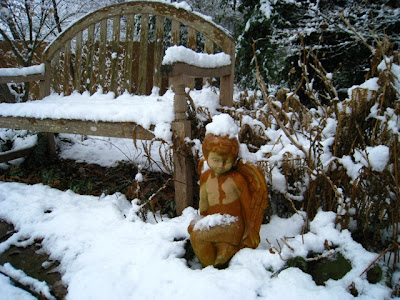Dem bones. Garden bones, that is.
Garden bones get to shine when the blooms have faded. Garden bones consist of those things in our gardens that give structure and strength, height and depth, bringing interest whether our gardens are a riot of color or devoid of blooms.
Just as our bodies would be a lifeless pile of skin,
so our gardens would look dead without bones!
So just what are these bones that I speak of?
 |
| A flagstone pathway leads through an arbor |
 |
| Evergreen shrubs line a flagstone path leading to a pond |
 | ||
| Trees add height and structure |
Evergreen trees or large shrubs have good form as well as function. Not only do evergreens anchor a garden design and give it structure, they can serve as a screen from the neighbors, as a windbreak from harsh northern winds, or just as a backdrop for deciduous shrubs and/or perennials.
Hollies, laurels, nandinas, and other shrubs with berries also provide food for winter birds.
 |
| Possumhaw Holly loaded with berries |
Just as "the leg bone connected to the knee bone and the knee bone connected to the thigh bone," so garden bones connect different areas of our gardens, tying them all together. Garden paths, whether made of stone, gravel, mulch or grass, allow the visitor to meander throughout the garden.
Well-placed seating invites visitors to sit a spell.
Even the layout of garden beds, whether in long sweeping curves or formal straight lines, constitutes this skeleton of the garden. Good bones give your garden visual appeal even before a single plant has gone in the ground...
...as well as after the plants have gone dormant.
 |
| Flagstone paths define the garden beds |
The sweeping lines of garden beds stand out when the blooms have taken a back seat. Ornamental grasses provide winter interest.
 |
| Shrubs form an evergreen skirt around the house |
When there is no competition from foliage,
the beauty of tree bark comes to the forefront, as well.
What once went unnoticed in our gardens now captures our attention.
the beauty of tree bark comes to the forefront, as well.
What once went unnoticed in our gardens now captures our attention.
 |
| Rough bark of Chinese Pistache |
 |
| Red twigs of 'Sango Kaku' Japanese Maple |
 |
| Cinnamon bark of 'Natchez' Crape Myrtle |
Large boulders seem to pop out of the landscape once again when the surrounding plants have gone dormant.
Trellises and other garden ornaments add interest to our gardens whether they are dusted with snow or accompanied by foliage or blooms.
Could your garden use a little backbone?
During this time when our gardens are dormant, look around at those blank spaces that are left behind, and see where you can incorporate some garden bones.
It just might breathe a little life into your garden...
even in the dead of winter.
Until next time...
Toni :-)









A nice summary of the winter interest elements Toni and a good suggetion...now is certainly the time to look since we just got our first snowfall of the year (still coming down and over 6 inches now).
ReplyDeleteToni, very true! This is the best time to take stock of the garden layout and make different plans. I love the examples you show us in this post!
ReplyDeleteAmen to that! Your arbor is beautiful!!
ReplyDeleteYour garden is so beautiful! And, still in the wintertime thanks to your good bones! I love the bark on your Japanese Maple and Crape Myrtle. And all your hardscaping!
ReplyDeleteThis comment has been removed by the author.
ReplyDeleteWell-said and well-done! One person calls this "designing for February", another calls this "designing in black and white". Both emphasize bones and forms, then color.
ReplyDeleteSpoken like a true Landscape Architect might. I agree and also with Desert Dweller. Good designers work all year round. Clients call in December for well laid plans for April. I have had large jobs that I start an entire year before. Site analysis is so complete that nothing is left to chance. And the structure is the garden for a large part of the year. Where not only is it the hardscape but the way light filters and shadows form. The way naked trees give interest and the way a perennial holds the snow. So much goes into good design.
ReplyDeleteWell thanks Toni! I was going to say my garden is like an octopus...but it isn't THAT bad! I'm working on bones and maybe someday it'll be able to stand up on it's own!! :-)
ReplyDeletethanks Toni very helpful, I need to fill the gaps of plants the wind took and hopefully one day will get some hard landscaping, your garden looks wonderful what ever time of year, Frances
ReplyDeleteYour garden has beautiful bones! It also has lovely color, even in the depth of winter. Thanks for the great tips and inspirational photos.
ReplyDeleteTrees really do shine in the winter garden, and your photos illustrate it beautifully!
ReplyDeleteWinter is really the time garden structure "shines." Love the flagstone paths!
ReplyDeleteAn excellent post and great bones... no loss of interest in your garden this time of year! L
ReplyDeleteGreat explanation of the concept. Awaiting a big snow storm tonight---nothing like snow to show off the bones. Carolyn
ReplyDeleteYour garden bones show up nicely. I've tried to add winter interest to my garden, but then we get 2 feet or more of snow and it's all buried.
ReplyDeleteYou have a beautiful garden with beautiful bones. I should have a little more interest for winter viewing in my own yard. Nice post.
ReplyDeleteYou do have some amazing bones in your garden! The flagstone path, arbor, pond...it is all the hardscape I dream of having some day....
ReplyDelete